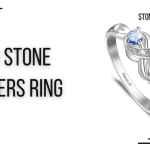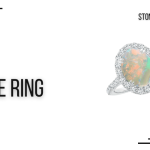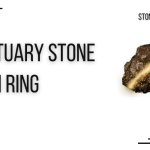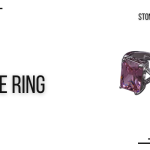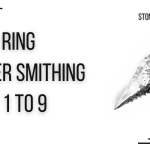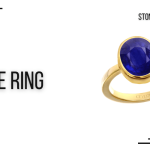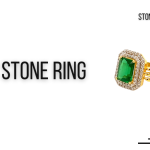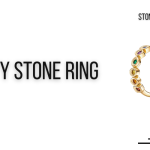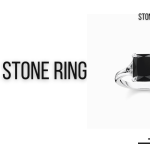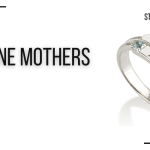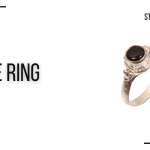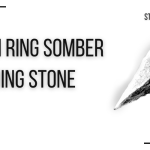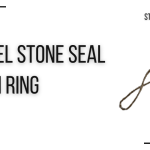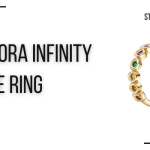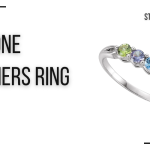Ah, the stone ring – more than just a sparkling gem held by a delicate band; it’s a testament to centuries of art, tradition, and human ingenuity. It’s an accessory with a story that transcends time. The historical context of these rings revolves around their use as powerful symbols, reflecting societal hierarchies and even serving as vessels for the divine. Picture the time when Pharaohs, adorned with intricate stone rings, ruled over the fertile lands of the Nile or when a medieval queen flaunted her emerald ring, radiating a clear message of wealth and prosperity. Let’s embark on this fascinating journey to uncover the secrets behind the stone ring, its significance across cultures, and why it remains a beloved accessory. After all, every stone tells a story. Let’s tune in.
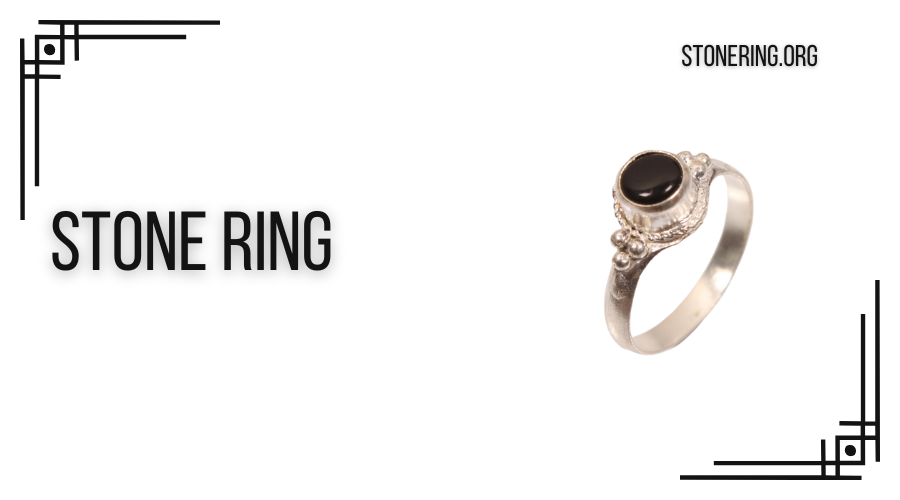
A Brief History of the Stone Ring
The stone ring, a gem that narrates tales from the annals of history, boasts of a rich heritage that spans different civilizations and eras. This fascinating accessory, born from intricate craftsmanship and profound artistic sensibilities, is a window to our ancestors’ world. Each epoch has imprinted its essence onto these magnificent pieces, making them a touchstone for power, wealth, and our perennial fascination with aesthetic brilliance. From Egyptian Pharaohs’ lavish courts to European monarchs’ regal halls, the stone ring has been a silent spectator, evolving with humanity, mirroring societal structures, and embodying our intrinsic penchant for beauty.
Yet, the stone ring is not merely an ancient vanity artifact. It is, in essence, a woven tapestry of cultures, a timeless chronicle etched in gold and gemstone. As you delve into the significance of these rings, they reveal tales of Roman aristocrats flaunting their status, Pharaohs asserting divine rule, and medieval sovereigns displaying their immense power. By unraveling its layered history, we gain a deeper appreciation for this wearable art form that subtly encapsulates the human journey. A stone ring is not just a piece of jewelry; it’s an ode to our creativity, a reflection of our trip, and a testament to our unending quest for beauty.
Stone Rings Through The Ages
1. A Sign of Status: Stone Rings in Ancient Egypt
In Ancient Egypt, the stone ring had a profoundly symbolic significance. It wasn’t just a piece of jewelry; it was a status symbol, a mark of divinity. The Pharaohs, regarded as earthly gods, wore these rings to reflect their divine status. The stones used, such as lapis lazuli, turquoise, and carnelian, each held specific meanings and were often set in gold, a metal associated with the sun god, Ra. These rings were ever-present in their lives, from participation in divine rituals to managing mundane tasks.
2. Vital Vessels: The Use of Stone Rings in Roman Times
During Roman times, the stone ring evolved as an essential societal marker. Initially, only the equestrian class was allowed to wear these rings. As time passed, the privilege of donning stone rings gradually spread through the societal ranks. The rings were often engraved with family crests or personal symbols, serving as a form of identity.
3. Royals and Rocks: The Importance of Stone Rings in Medieval Europe
The stone ring became even more critical in Medieval Europe, especially among royals. The rings were adorned with precious gemstones like diamonds, rubies, and sapphires, displaying the luxury and power of the monarchy. Stone rings were also used strategically in diplomacy. They were gifted to other nobles as a show of favor or to affirm alliances. A monarch’s hand, studded with numerous stone rings, displayed their power, influence, and strategic relationships.
In conclusion, the stone ring has a rich history that spans centuries and civilizations. While it’s a piece of beautiful jewelry, it’s also so much more. It’s a symbol of power, a mark of identity, a tool of diplomacy. It’s a wearable testament to our societal norms and customs, reflecting the evolution of our civilizations. Each stone ring is not just an accessory but a piece of history, a silent witness to our past.
The Art of Stone Ring Craftsmanship
Crafting a stone ring is a harmonious blend of artistic vision, technical skill, and understanding of the profound symbiosis between stone and metal. This creative endeavor transcends mere manipulation of materials; it is a dance of elements, a dialogue between the artisan and the raw materials.
1. Chip Off the Old Block: Carving Techniques for Stone Rings
Carving a stone for a stone ring is no small feat. It demands the precision of a surgeon and the vision of a sculptor. The artisan must respect the stone’s natural character, flaws, and features, using them to enhance the final design. Techniques such as faceting, where the stone is cut into multiple flat surfaces or ‘facets’ to maximize its brilliance, and cabochon, where the stone is shaped and polished into a smooth, rounded surface, are commonly used. The challenge lies in revealing the stone’s beauty without compromising its integrity, a delicate balancing act that defines the artisan’s skill.
2. Metal Meets Stone: Integrating Stone into Metal Rings
The next phase in creating a stone ring is integrating the stone into the metal ring. This critical process requires an in-depth understanding of metallurgy. Gold, silver, and platinum are frequently utilized metals because of their flexibility and longevity. The artisan molds the metal to create a setting that snugly holds the stone. Techniques like prong, bezel, and channel setting are employed, each offering a different aesthetic and level of security for the stone. The goal is a seamless unity between metal and stone, a marriage that celebrates the distinct beauty of both elements.
3. Colorful Creations: How Different Stones Impact Aesthetics
Finally, the choice of stone plays a crucial role in the aesthetic appeal of a stone ring. Each stone’s unique color and character imparts a different vibe to the ring. Diamonds lend an air of classic elegance, emeralds exude an earthy allure, and rubies bring a touch of passionate luxury. In their creative wisdom, the artisan selects the stone that complements the design’s overall vision, enhancing not just the visual appeal but also the symbolic significance of the stone ring.
The art of crafting a stone ring is a journey that begins with a raw stone and a metal block and ends with a creation of unmatched beauty and personal significance. It embodies human creativity, a testament to our ability to perceive beauty in raw elements and our skill in transforming these elements into a tangible form of expression. A stone ring is not just a piece of jewelry; it’s a celebration of the extraordinary bond between human ingenuity and nature’s bounty.
The Symbolism of Different Stones
In the jewelry world, every stone carries a unique significance, each a symbol expressing an unspoken language. The stone ring, depending on its gem, narrates its distinct tale.
1. Crystal Clear: Quartz Stone Rings and Clarity
Quartz rings play a crucial role in the realm of gemstones by symbolizing clarity and purity. The wearer of a quartz stone ring often seeks transparent communication and clear thinking, thus representing a deep appreciation for sincerity and mental clarity. Quartz also promotes spiritual growth and enlightenment, making its ring a symbol of spiritual evolution.
2. Tough Love: The Strength Symbolized by Diamond Rings
Diamonds, the epitome of luxury and desire, signifies resilience and strength in the realm of gemstones. A diamond’s formation under extreme heat and pressure mirrors the hardships and trials one overcomes in life. Therefore, a diamond stone ring is a testament to the wearer’s resilience and inner strength. It signifies the ability to face life’s pressures bravely and to transform challenges into beautiful outcomes, similar to a diamond’s creation process.
3. Green with Envy: Emerald Rings and Their Ties to Prosperity
Emeralds, revered for their lush green hue, symbolize prosperity and renewal. An emerald stone ring does not merely represent material wealth. It is also a symbol of personal growth, harmony, and renewal. The wearer of an emerald ring often seeks to embody these qualities, striving for personal success, abundance, and a harmonious connection with the surrounding world.
The choice of stone in a stone ring carries deep symbolic significance. Each gemstone tells a story, reflecting the wearer’s journey, inherent values, and aspirations. Therefore, a stone ring is not merely a decorative accessory but a personal statement and a reflection of the wearer’s inner world.
Care and Maintenance of Stone Rings
A stone ring is a testament to time, a symbol of personal style, and often, a piece of jewelry with immense emotional value. Consequently, care and maintenance of these beautiful pieces become essential to owning them.
1. Keeping the Sparkle: Proper Cleaning Techniques for Stone Rings
The sparkle of a stone ring can be maintained by adopting proper cleaning techniques. A gentle cleaning solution of lukewarm water and mild dish soap works wonders for most stones. Using a soft cloth or toothbrush with gentle bristles is best to clean the ring. This method will effectively eliminate dirt or residue without causing any harm. However, it’s essential to remember that some stones, like pearls, opals, and emeralds, need special care as they’re sensitive to certain cleaning solutions. Therefore, knowing the specific cleaning requirements for your stone can help maintain its shine and integrity.
2. Hold Tight: Ensuring the Stone Stays Secure in Its Setting
A stone ring often becomes a part of the wearer’s persona, a constant in their daily life. This frequent usage can loosen the stone’s setting over time. Regular checks to ensure the stone isn’t wobbly or loose can help prevent any potential loss. If the stone does seem open, it’s advisable to take the ring to a professional jeweler who can tighten the setting, ensuring the stone remains secure in its place.
3. Life’s Little Bumps: What to Do When Your Stone Ring Gets Damaged
Despite our best efforts, life happens, and our precious stone ring might get damaged. A chipped stone or a scratched band can be disheartening. In such cases, it’s best to contact professional jewelers who can assess the damage and suggest suitable repair options. If the stone is chipped, they might recommend reshaping or replacing it. They might suggest repairing or replacing the band if the band is damaged.
Caring for a stone ring combines regular maintenance, preventative measures, and dealing with the unforeseen. By ensuring proper cleaning, regular checks for stone security, and seeking professional help when damage occurs, your stone ring can continue to sparkle and narrate its timeless tale. These pieces are more than just accessories; they are storytellers, personal symbols, and heirlooms that can be passed down through generations. Their care and maintenance aren’t just about preserving their physical beauty and honoring their sentimental value.
Choosing the Right Stone Ring
The charm of a stone ring lies not merely in its radiant beauty but in its ability to mirror the personality of its wearer. Choosing the right stone ring is like finding a piece of jewelry that sings harmoniously with your soul.
1. Personalize It: Matching Stone Rings to Different Personalities
Selecting a stone ring that aligns with the wearer’s personality can enhance its significance. A call with a large, brightly colored gemstone might appeal to individuals with a bold, outgoing personality. People who value subtlety and sophistication might prefer a smaller, more delicately designed stone. The call can serve as an extension of the person’s identity.
2. Birthstones and Beyond Stone Rings as Personalized Gifts
Each month has a specific gemstone, known as a birthstone. Choosing a stone ring with a person’s birthstone can make the gift feel personal and meaningful. Such a ring signifies that the giver put thought into the present, which can enhance the emotional value of the call for the recipient.
3. The Cost of Beauty: Evaluating Price Points for Stone Rings
Finally, the price point is essential when choosing a stone ring. Factors influencing the price of a stone ring include:
- The type and size of the stone.
- The type of metal used in the band.
- The complexity of the design.
While rings featuring diamonds and precious gemstones like rubies, sapphires, and emeralds are more expensive, those with semi-precious stones like amethyst, topaz, or garnet often offer a more affordable range. Balancing personal taste and budget ensures the ring brings joy without causing undue financial strain.
In sum, selecting the right stone ring involves:
- Considering the wearer’s personality.
- Looking at options for personalization, such as using birthstones.
- Considering the price point.
This process can enhance the ring’s emotional significance, making it a piece of jewelry and a meaningful symbol of the wearer’s personal story.
Conclusion
From the illustrious courts of ancient empires to today’s vibrant fashion landscape, the appeal of the stone ring remains as unwavering as the enduring strength of the diamonds they often bear. As more than a mere accessory, a stone ring symbolizes a personal narrative, a fragment of history elegantly curled around a finger. Whether it’s the quartz that echoes clarity, the diamond that embodies resilience, or the emerald that whispers tales of prosperity, each stone ring tells a unique story, resonating with the wearer’s soul. As you find your perfect pebble, remember you don’t merely don a piece of jewelry but embrace a part of timeless tradition. A tradition that links you to the ancients, reflecting our inherent fascination with beauty and the human capacity to value symbolism. Ultimately, a stone ring is not just an adornment; it’s a living testament to our shared history and a personal emblem continuing to capture the imaginations of future generations.

Harry Son, a luminary in the stone ring industry, blends passion with craftsmanship to create timeless pieces. With an eye for detail and dedication to quality, Harry shares his expertise and unique design perspectives. Through insightful articles, he guides readers on a journey to discover the allure and significance of stone-adorned rings, offering a glimpse into the world of exquisite jewelry craftsmanship.

